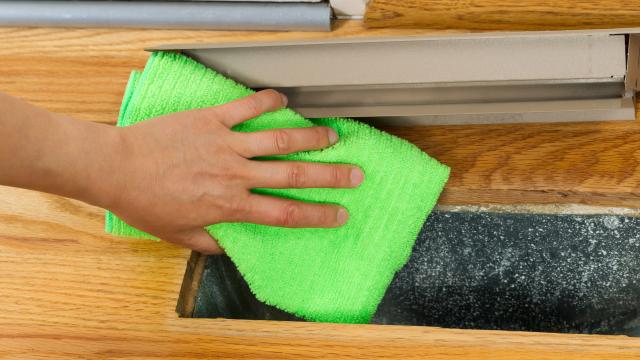If you’re lucky enough to have air conditioning, you probably don’t think about the air vents unless something goes wrong or the filter needs replacing. Changing out the filters once a month only solves half the problem, though, if the vent itself is just circulating dust and dander right back into your home. Home maintenance site Review Homes Warranties suggests cleaning your vents once or twice a year to keep the pathways clean.
Cleaning vents at the beginning of spring and autumn will help promote cleaner airflow throughout the year, but you should consider even more frequently — two or three times a year — if you have pets or individuals in the home with respiratory conditions like asthma or chronic obstructive pulmonary disease.
Three ways to clean your air ducts
Cleaning your air ducts doesn’t require making your own vent cleaning kit (it might be an exciting DIY venture for you, but pretty unnecessary.) You can clean them with a few simple household items — specifically your vacuum cleaner, a butter knife, a washrag, a tub of soapy water, and a sponge.
Clean with a vacuum, butter knife, and a rag
First, take your vacuum with the hose extension (or handivac) and vacuum the visible dust outside the air vent. (You might also use a can of air to blast stubborn dust from vent registers.) Then, remove the vent register, which is the grating over the duct entrance. Some registers are removed with a firm pull, while others are secured with screws and need a screwdriver. Make sure to place the screws in a safe place for reattachment afterward, then wet your dishrag with a small amount of water (the rag should be wet but not enough to soak the vent), wrap it over a butter knife, and feed it in between the vent blades to clean out the dust stuck inside. Home Advisor provides useful tips and instructions for executing this technique on their site.
In the tub
For a deeper clean of your vent registers, you can take them to the sink or tub. Let them soak for three to five minutes in soapy water to loosen the grime, then take a sponge and clean off any remaining muck. Rinse with the faucet or detachable shower head and lay the registers out to dry, which should take anywhere from 5-10 minutes. If you have any laying around, you can use Turtle Wax or a similar product to make it harder for future dust to stick to your vents.
[referenced id=”1041674″ url=”https://www.lifehacker.com.au/?p=1041674″ thumb=”https://www.gizmodo.com.au/wp-content/uploads/sites/4/2021/01/03/ezky01x1ynj7weswzwpr-300×168.jpg” title=”How to Clean and Sanitise Your Humidifier, Because It’s Probably Gross in There” excerpt=”Humidifiers can make breathing and sleeping more comfortable in the winter, giving off a gentle mist that can help with everything from dry sinuses and bloody noses to cracked lips and skin. But if you’re not cleaning your humidifier regularly, it can breed mould or bacteria, and make you feel…”]
Get inside the vent pathways with a vacuum
Use a regular home vacuum or a standard shop vac to vacuum the outside of your vent first, then take the long hose or arm of your vacuum into the open duct to vacuum out the accumulated dust in the duct pathway. Repeat that at each vent opening throughout the house, which can take some time depending on the number of vents, but worthwhile to minimise the circulation of dust and allergens in your home.
When to call a professional
If you don’t feel equipped to clean them yourself, or need more serious work done, you should hire a professional. The EPA provides a shortlist of situations needing professional attention when it comes to cleaning out your duct system, including:
- There is substantial visible mould growth inside hard surfaces (e.g., sheet metal) ducts or on other components of your heating and cooling system.
- Ducts are infested with vermin (e.g., rodents or insects).
- Ducts are clogged with excessive amounts of dust and debris and/or particles are actually released into the home from your supply registers.
While mould and rodent infestations present bigger issues for your home, some small components of your HVAC system require professional attention for regular maintenance and cleaning. Hiring a professional is also best for more delicate parts of your system like fan motors, heat exchangers, and cooling coils that may be covered in dust. Those need a little more experience than what your standard homeowner with a vacuum and butter knife can provide.

Leave a Reply
You must be logged in to post a comment.